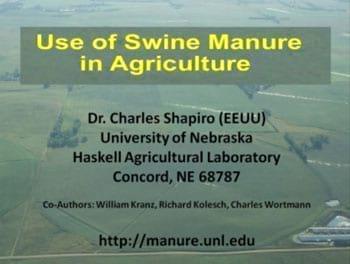High Yields and a Cost Savings with Liquid Manure
Published: April 4, 2008
Source : Ohio State University Extension
Coming off of several years of research that showed that applying swine manure to post-emergent corn produced comparable or higher yields to commercial urea, OSU Extension educators in Putnam and Hancock counties hoped to find the same results in treating pre-emergent corn.
“We want to find out if a farmer could plant corn and then use a dragline manure application system to sidedress before the corn even comes up out of the ground,” said Glen Arnold, an OSU Extension educator in Putnam County. “In 2007, we completed research on three pre-emergence corn plots using liquid swine manure as the primary nitrogen source. Two of the three plots yielded the same or higher compared to urea.”
Arnold, who has been leading the research since 2004, will present the latest findings at the Great Lakes Manure Handling Expo on July 9 at the Molly Caren Agricultural Center in London, Ohio. Arnold said that he hopes to show farmers that manure application, which is generally practiced in the fall, can be just as valuable in the spring, and it could save farmers money, as well.
“At today’s fertilizer prices, using manure from livestock could easily save farmers $75 to $100 per acre in purchased fertilizer,” said Arnold.
Not only can springtime manure application potentially fatten a farmer’s wallet, but it can also benefit the environment.
“There is less chance for nutrient loss in the spring as opposed to the fall, because the manure is actually going to a growing crop that will utilize its nutrients,” said Arnold. “We’ve always known that manure provides good nutrients for the soil. The idea is to find a way to make better use of it than applying it to bare fields in the fall.”
He added that farmers could potentially be throwing away an economically valuable resource if a spring or early summer application to growing crops is not a consideration. In Putnam County, for example, if farmers fully utilize the ammonia nitrogen in their liquid swine manure they could save over $500,000 annually through reductions in purchased nitrogen, said Arnold. Putnam County is the fourth-largest swine-producing county in the state.
Arnold and his colleagues will continue their research, getting a boost from a $10,000 grant from the Ohio Pork Producers Council. Barnyard Supply in Sidney, Ohio, has also donated equipment to use in research plots.
The Great Lakes Manure Handling Expo is sponsored by Ohio State University Extension and the Ohio Agricultural Research and Development Center, Michigan State University, Purdue University, Penn State University and Cornell University. Additional sponsors include Ohio Composting and Manure Management and the Midwest Professional Nutrient Applicators Association.
The theme of the Great Lakes Manure Handling Expo is “The Economics of Recycling,” and will include commercial field demonstrations, educational demonstrations, educational sessions, and commercial vendor displays.
Session topics participants can look forward to include: calculating the value of manure nutrients; the benefits of proper equipment calibration; the importance of accurate record-keeping; how communication among applicator, producer and regulatory agency can improve application and the bottom line; safety precautions in manure application and storage; and case studies of farmers who will share their stories about manure management.
Educational demonstrations taking place during the event include solid manure application rates, liquid manure application rates, preferential flow, calibration of manure application equipment, stockpiling best management practices, compaction, slurry seeding and equipment safety.
Source
Ohio State University Extension Related topics
Join to be able to comment.
Once you join Engormix, you will be able to participate in all content and forums.
* Required information
Would you like to discuss another topic? Create a new post to engage with experts in the community.
Create a post




